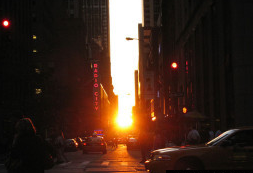
Dull men adore orderliness. Orderliness is especially gratifying when has amazing results.
A fallout from Manhattan’s orderly grid system of streets is Manhattanhenge, which occurs twice each year when the sun is aligned exactly with Manhattan’s east/west streets — presenting stunning views of the sunset. (The grid system was the subject of our May 5 newsletter [click here].)
The name “Manhattanhenge” was coined by astronomer Neil deGrassse Thyson, Director of the Hayden Planetarium at the American Museum of Nature History in New York. As Thyson explains, “Manhattanhenge takes place when the setting sun aligns precisely with the Manhattan street grid, creating a radiant glow of light across Manhattan’s brick and steel canyons, simultaneously illuminating both the north and south sides of every cross street of the borough’s grid. A rare and beautiful sight.”
2012
The 2012 dates are May 30 and July 11. Unfortunately, on May 30 the view was dampened by bad weather. A cold front with rain showers moved across Manhattan — disappointing spectators as well as photographers hoping to get more stunning photos.
Street grid tilts 29 degrees to the east, thus not aligned with equinoxes
The sunset point moves each day. It moves north until the first day of summer (the summer equinox), then south until the first day of winter (the winter equinox). The sun rises precisely to the east and sets precisely to the west only on the equinoxes. But Manhattan’s grid of streets is not exactly aligned with geography’s north/south course. The streets tilt 29 degrees to the east of geographic north. Therefore, unlike Stonehenge where the stones are properly aligned north/south, the days to view the sunsets at Manhattanhenge are not the same as the summer and winter equinoxes.
It’s not “Manhattansolstice”
“Solstice” is a Latin word that means “stopped sun.” At a solstice, the sun stops moving for a moment and then reverses to move in the opposite direction. At Manhattanhenge, the sun is still moving.









